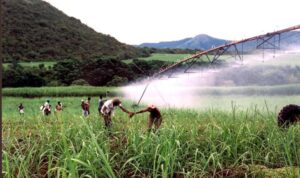Introduction
If you were asked to list a hundred things you could do with bamboo, your first thought might be that bamboo poles can be tied together to make a fence, a bridge, a shack or some kind of settlement. Bamboo’s uses do indeed include construction (the costs of bamboo dwellings compare very favourably with conventional materials).
You would think that it can replace the need for trees as a source of wood (isn’t that great!) All types of furniture can be made, as well as fittings such as window blinds, fencing and flooring. It might come to you that charcoal can be produced, cutting-boards and various arts and crafts.
But would you think textiles? Bamboo towels and socks? Bamboo soap? Bamboo toilet paper? Bamboo beer, bamboo bicycles and bamboo corrugated roof sheets?
Bamboo does not have a hundred uses: studies done by the Industrial Development Corporation (IDC) and other role players show over a thousand! Clearly there is a lot more to bamboo products and bamboo processing than would immediately occur to the reader. Not only does bamboo have many uses, it is a non-invasive crop that can help develop agriculture and contribute towards lifting human beings out of poverty by creating jobs in rural areas.
Benefits of Bamboo
- combats soil erosion
- reforests areas denuded of vegetation caused by demand for cooking fuel
- removes heavy metals and other pollutants from polluted water
- responds to climate change through carbon sequestration
- provides shade and creates windbreaks for food crops
- can be grown as a living fence to keep animals in or out
- provides food for humans in the form of shoots and animal fodder in the form of leaves
- assists in capturing water allowing it to percolate instead of flowing away
- can be planted as noise barriers and windbreaks
- develops greener more aesthetically pleasing settlements and a better living environment
- provides a habitat for wildlife and improved biodiversity
- contributes to economic development and creation of jobs at a local level
- increases environmental awareness through communities locally and from publicity nationally
- creates opportunities for communities to enter the New Green Economy and so creates rural wealth instead of the standard poverty relief programmes
Source: www.trees.co.za. The above list accompanied the previous “Bamboo for Africa” programme.
International business environment
- Bamboo, renowned for its rapid growth and eco-friendly properties, is cultivated in Asia, with China leading in production and export. In 2022, China exported more than 65% of the world’s bamboo exports. However, other regions, such as South America and Africa, are becoming significant players in the bamboo products industry.
- In September 2023, the Bamboo Trust Fund, a revolutionary initiative in the UN Decade Action Plan, was launched to leverage bamboo’s vast potential in tackling urgent global issues like climate change and biodiversity loss.
- Global bamboo products market was valued at USD 75.6 billion in 2023, expected to reach USD 138.9 billion in 2031, with a CAGR of 7.9% for the forecast period between 2024 and 2031.
Source: Markets & Data. 2024. Global Bamboo Products Market Assessment. Available at www.marketsandata.com/industry-reports/bamboo-products-marketOffline and online channels distribute bamboo products in domestic and international markets. Major companies usually have a distribution network of regional offices. Small-scale manufacturers use e-commerce portals to sell directly to customers. Furniture is the major bamboo product, followed by industrial products, shoots (edible), raw material and other (Grand View Research, 2022).
Further reading
- Markets & Data. 2024. Global Bamboo Products Market Assessment. Available at www.marketsandata.com/industry-reports/bamboo-products-market
- Grand View Research. 2022. Bamboo Market Analysis Report. Available at www.grandviewresearch.com/industry-analysis/bamboos-market.
- International Network For Bamboo And Rattan, www.inbar.int
- The World Bamboo Organisation, http://worldbamboo.net Find the proceedings from the last World Bamboo Workshop on the website.
- Environmental Bamboo Foundation – www.bamboocentral.org
- Find “New Bamboo Industries and Pro-Poor Impacts: Lessons from China and Potential for Mekong Countries”, a study done by Oxfam Hong Kong and the Mekong Private Sector Development Facility (MPDF).
Investment schemes
Along with the incredible potential in this industry, it is perhaps inevitable that some investment schemes arise that sound too good to be true. Be cautious when bamboo plantation investments promise 25 to 25% returns from year one. Bamboo needs around four years to develop the 80 – 100mm culms. These culms have to mature for at least 24 months to gain the strength needed for the products.
Local business environment
Find the overview of the bamboo industry in China, Africa and South Africa in the article by Scheba, A., Mayeki, S. & Blanchard, R (see below for full citation). The points below are taken from it.
- EcoPlanet Bamboo in the Eastern Cape belongs to a leading multinational company specialising in substituting wood fibre products with bamboo.
- Green Grid Beema Bamboo in KwaZulu-Natal received funding from South Africa’s Green Fund and is a national demonstration project for generating bioenergy from bamboo.
- Smaller bamboo projects also operate in the Eastern Cape or KwaZulu-Natal, because these provinces are considered to be the most conducive regions for commercial growing due to soil, climate and rainfall conditions.
- In addition to commercial growers, there are nurseries/tissue culture companies, specialised retailers, government agencies and consulting companies across the country, which have engaged in the local bamboo industry.
Source: Scheba, A., Mayeki, S. & Blanchard, R. 2018. “Bamboo for green development in South Africa?” Human Sciences Research Council. Available at www.hsrc.ac.za/en/review/hsrc-review-jan-march-2018/bamboo-for-green-dev-sa
Role Players
Find these in the Agribook eBook and hard copy which can be bought on our website.
Websites and publications
- See the websites listed earlier on this page. Those of role players provide useful information e.g. find the presentations by numerous bamboo role players on the ECDC website, www.ecdc.co.za.
- Find the Human Sciences Research Council presentation “How can South Africa’s Green Economy projects work better for the poor?” (2017, May) at www.hsrc.ac.za/uploads/pageContent/8216/EPD%20seminar.31%20May%202017.Andreas.pdf
- Find the thorough notes on bamboo at www.plantationsinternational.com/bamboo/ Although “Bamboo products and trade” is dated, it gives a paragraph or two for the various products made from bamboo. Find it at www.fao.org/docrep/pdf/010/a1243e/a1243e04.pdf
- Several EcoPlanet and other videos on bamboo can be found on YouTube. See “The Power of Job Creation: EcoPlanet Bamboo” and “Bamboo: The Miracle Plant”. Others are “Bamboo for Africa” and “RES BIO ENERGY – DGB Bamboo Plantation”
Some articles:
- Reporter. 2022, September 21. “Woolworths launches lipsticks packaged in paper and bamboo”. Bizcommunity. Available at www.bizcommunity.com/Article/196/178/231763.html
- Van der Walt T. 2020, November 2. “7 natural fibres to consider if you want go green with your wardrobe”. IOL. Available at www.iol.co.za/lifestyle/green-living/7-natural-fibres-to-consider-if-you-want-go-green-with-your-wardrobe-cb34dd65-5d7a-4f56-bc8b-df069b63c552
- Whiting K. 2020, August 3. “Meet the Woman Making Bamboo Bikes in Ghana”. World Economic Forum. Available at www.ecowatch.com/bamboo-bike-ghana-2646871008.html
- Laville, S. 2018, November 22. “Bamboo house: easy to build, sustainable Cubo wins top prize”. The Guardian. Available at www.theguardian.com/world/2018/nov/22/bamboo-house-easy-to-build-sustainable-cubo-wins-top-prize
- Paramita E. 2018, March 22. “How to grow a bamboo industry”. World Agroforestry Centre. Available at http://blog.worldagroforestry.org/index.php/2018/03/22/how-to-grow-a-bamboo-industry/
- Reporter. 2018, January 20. “Innovative materials from bamboo are helping a new industry to sprout”. The Economist. Available at www.economist.com/business/2018/01/20/innovative-materials-from-bamboo-are-helping-a-new-industry-to-sprout
- Carter L. 2017, November 29. “WATCH: Bathurst bamboo plantation grows a sustainable future”. Talk of the Town. Available at www.talkofthetown.co.za/2017/11/29/bathurst-bamboo-plantation-grows-sustainable-future/
Our thanks to Willem Malherbe (National Bamboo Association of South Africa) and Pieter Joubert for feedback on the draft chapter.






